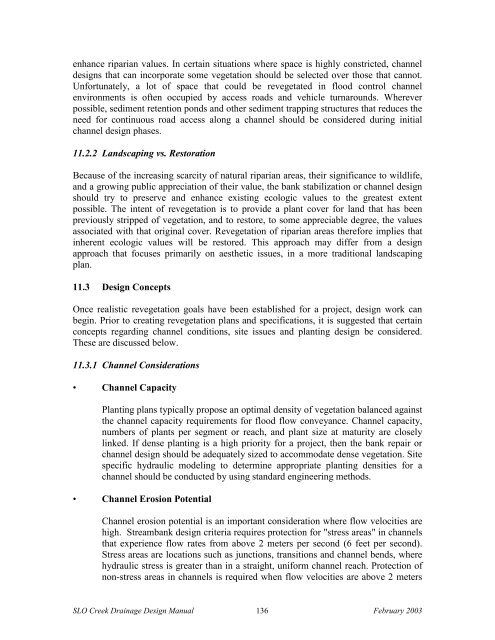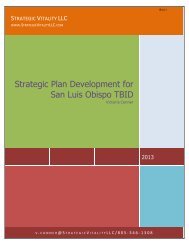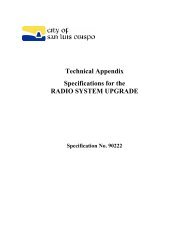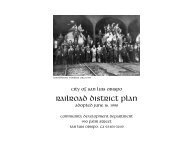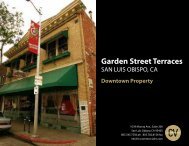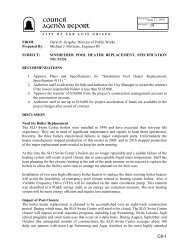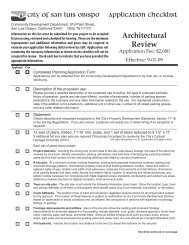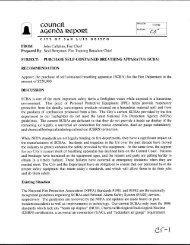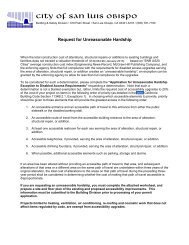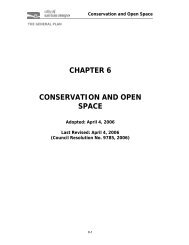Drainage Design Manual - the City of San Luis Obispo
Drainage Design Manual - the City of San Luis Obispo
Drainage Design Manual - the City of San Luis Obispo
Create successful ePaper yourself
Turn your PDF publications into a flip-book with our unique Google optimized e-Paper software.
enhance riparian values. In certain situations where space is highly constricted, channeldesigns that can incorporate some vegetation should be selected over those that cannot.Unfortunately, a lot <strong>of</strong> space that could be revegetated in flood control channelenvironments is <strong>of</strong>ten occupied by access roads and vehicle turnarounds. Whereverpossible, sediment retention ponds and o<strong>the</strong>r sediment trapping structures that reduces <strong>the</strong>need for continuous road access along a channel should be considered during initialchannel design phases.11.2.2 Landscaping vs. RestorationBecause <strong>of</strong> <strong>the</strong> increasing scarcity <strong>of</strong> natural riparian areas, <strong>the</strong>ir significance to wildlife,and a growing public appreciation <strong>of</strong> <strong>the</strong>ir value, <strong>the</strong> bank stabilization or channel designshould try to preserve and enhance existing ecologic values to <strong>the</strong> greatest extentpossible. The intent <strong>of</strong> revegetation is to provide a plant cover for land that has beenpreviously stripped <strong>of</strong> vegetation, and to restore, to some appreciable degree, <strong>the</strong> valuesassociated with that original cover. Revegetation <strong>of</strong> riparian areas <strong>the</strong>refore implies thatinherent ecologic values will be restored. This approach may differ from a designapproach that focuses primarily on aes<strong>the</strong>tic issues, in a more traditional landscapingplan.11.3 <strong>Design</strong> ConceptsOnce realistic revegetation goals have been established for a project, design work canbegin. Prior to creating revegetation plans and specifications, it is suggested that certainconcepts regarding channel conditions, site issues and planting design be considered.These are discussed below.11.3.1 Channel Considerations• Channel CapacityPlanting plans typically propose an optimal density <strong>of</strong> vegetation balanced against<strong>the</strong> channel capacity requirements for flood flow conveyance. Channel capacity,numbers <strong>of</strong> plants per segment or reach, and plant size at maturity are closelylinked. If dense planting is a high priority for a project, <strong>the</strong>n <strong>the</strong> bank repair orchannel design should be adequately sized to accommodate dense vegetation. Sitespecific hydraulic modeling to determine appropriate planting densities for achannel should be conducted by using standard engineering methods.• Channel Erosion PotentialChannel erosion potential is an important consideration where flow velocities arehigh. Streambank design criteria requires protection for "stress areas" in channelsthat experience flow rates from above 2 meters per second (6 feet per second).Stress areas are locations such as junctions, transitions and channel bends, wherehydraulic stress is greater than in a straight, uniform channel reach. Protection <strong>of</strong>non-stress areas in channels is required when flow velocities are above 2 metersSLO Creek <strong>Drainage</strong> <strong>Design</strong> <strong>Manual</strong> 136 February 2003


